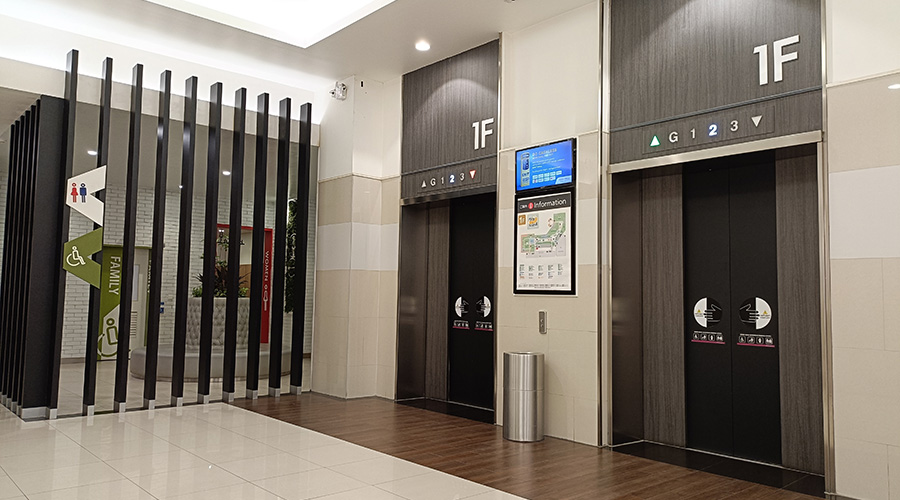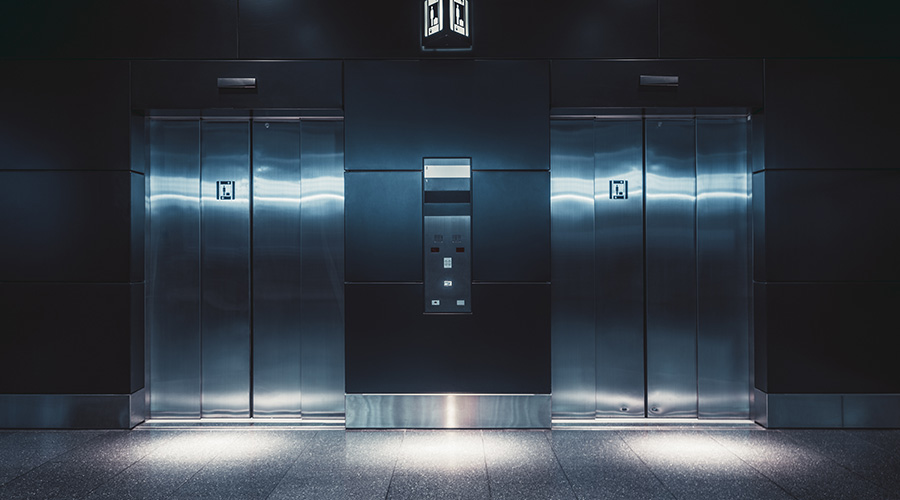The Right Elevator Service Agreement Minimizes Downtime
OTHER PARTS OF THIS ARTICLEPt. 1: This Page
Even though the tightening economy is forcing many facility executives to rein in costs, keeping elevators running properly is often a high priority. Doing so requires a comprehensive preventive maintenance program.
“Elevators still are mechanical devices, and require ongoing, consistent maintenance to be safe,” says Jack Tornquist, vice president of the elevator consulting group with Lerch Bates. Moreover, an ongoing maintenance program often is required by code.
As a starting point, facility executives will want to regularly monitor how their elevators are performing. For instance, watching the wait times tenants are experiencing once they push an elevator’s button. In most Class A office buildings, wait times are expected to be about 20 to 30 seconds from the time a button is activated, says Glenn Rodenheiser, director of service sales and national accounts with Schindler Elevator Corporation.
Another attribute to check is the elevator’s stopping procedures. The car should stop level or within a quarter-inch of the floor to minimize the risk of occupants tripping as they enter or leave the elevator, says Tornquist. Facility executives also should check that phones inside the elevators are in working order and that they connect to the monitoring entity, he says.
The doors shouldn’t open and close so quickly that tenants worry they’ll get caught if they move too slowly when exiting and entering the elevator. Some elevator consultants try to boost the speeds at which the doors operate, to cut trip times, but tenants often prefer a slightly slower pace, says Richard Lockridge, director of business development with Fujitec America, Inc. “You want a balance. You don’t want (the doors) to creep along, but you don’t want Star Trek speeds, either.”
Facility executives also will want to look at callout rate, or the number of unplanned service outages during a set time period, says Jay Dietz, director of services with KONE. This can be expressed either as the number of calls experienced during a quarter or year, or as the “mean time between call outs.” So, if an elevator requires maintenance about once each quarter, the mean time between failure would be 90 days.
Often, it makes sense to separate service calls into those that are controllable and have a technical cause, and those that are uncontrollable from an elevator maintenance perspective. This second group includes calls prompted by inappropriate use of the elevator, such as a call to repair a door that’s knocked off track due to a tenant’s carelessness. The goal for the elevator company is to reduce the rate of controllable outages to the current industry benchmark of about one call per quarter, Dietz says.
That’s not to say that facility executives can ignore the ways in which tenants use (or abuse) the elevators. For instance, if tenants are regularly jamming large equipment into the elevators and denting the sides, facility executives should take action. That may mean posting signs, or talking with corporate management to spread the word.
Frequent service calls for the same elevator typically is a signal of deeper problems that should be raised with the service company. Similarly, wait times that are growing longer will warrant an investigation. The reason may be as simple as a large tenant that has changed its work hours, affecting traffic flow in the building. Or the change may result from a problem with the elevator controls.
While monitoring the elevators’ performance is critical, proper maintenance usually requires professional assistance. Experts say the focus should be on preventive, rather than call-back, maintenance. Preventive maintenance consists of scheduled appointments during which elevator technicians can check whether the elevator is running as it should be. Call-back maintenance, as its name implies, occurs when the building engineer or facility executive calls the elevator company because an elevator isn’t working properly. The technicians focus on investigating and resolving the immediate problem.
Evaluating Service Agreements
Until the 1990s, most elevator maintenance was handled by the companies that actually manufactured the elevators, says Lockridge. Now, elevator service companies have entered the marketplace, adding competition. While that offers facility executives more choices, it’s still important to make sure they’re getting the most for their money.
If the manufacturer’s service agreement is competitively priced, it generally makes sense to go with it, Tornquist says. Given that the company designed and built the elevator, its employees are likely to be experts.
Ideally, the contract period should cover at least five years, he adds. The longer time period is one sign that the company is serious about the business. They’re more likely to be making the appropriate investments in people and equipment needed to remain a contender in the marketplace.
The contract should be tailored to equipment type, age and patterns of use, rather than simply follow a generic maintenance plan. “That’s really the underpinning of achieving performance parameters,” Dietz says.
Many service contracts today are being structured as performance-based agreements, Tornquist says. In other words, the effectiveness of the service team is measured by the number of call-backs or unscheduled service outages that occur over a given time period. For instance, the contract may state that call-back appointments are to be limited to three per year. If the actual results come in better than this, the maintenance company may receive a bonus; if results are poorer, the company may incur a penalty.
Another trend is a greater focus on the elevators’ uptime, or the percent of time that they’re running as they should, says Rodenheiser. Ideally, the elevators will achieve 99.5 uptime, with the remaining .5 percent of time dedicated to maintenance. Rodenheiser says that this is a lofty goal, given that some elevators are decades old and require more frequent maintenance. However, facility executives should know how close to this goal the elevators come, so they can watch for trends and make sure the performance doesn’t slip.
The exact maintenance schedule will vary with the type of elevator, as well as its age and the level of use it experiences. Code requirements in different municipalities may require annual, or even quarterly or monthly testing, says Rodenheiser. Many within the industry recommend monthly testing.
As part of its services, the provider should develop and maintain a database that identifies all the elevator equipment, along with their age, condition, usage patterns and maintenance records. A team should be assigned to each building, so that the facilities team knows who to call when problems occur. Ideally, the company also will offer remote monitoring of the elevator equipment, and be able to alert the facility executive of any potential problems, as well as keeping any problems from getting worse. “In a perfect world, we’ll know a unit is having problems before the customer does,” says Rodenheiser. Some companies also offer Web-based tools that allow facility executives to check such elevator performance data as trends, open invoices, and proposed equipment upgrades.
Get What You Pay For
Of course, the adage “if it sounds too good to be true, it probably is,” applies to elevator maintenance just as much as it does with other products and services. Bargain-bin contract prices likely won’t provide for a true preventive maintenance plan, but will focus more on call-back maintenance, Lockridge says. Or the contract may allow the maintenance company greater discretion in deciding how often they’ll service the equipment.
In contrast, a comprehensive service plan will identify the number of hours of maintenance each elevator will receive each month; depending on the age of the elevator, this can range from one to about five hours. The plan also should outline the services to be performed. For instance, the technicians should clean the car tops and machine rooms to keep dust and grime from getting into the equipment. They also should inspect the machine room and check that the drives are working properly.
The checkup also may include different tests of the elevator’s operation. For instance, the technician may trip the governor on a traction elevator to make sure the safety equipment works properly, or pressure test hydraulic elevators to make sure they can handle the loads they’re carrying.
The goal when analyzing a maintenance agreement is to focus on value, rather than the price tag, Lockridge says. Companies that offer really low bids may require more supervision to ensure that they’re not skimping on their obligations.
Another area to check is the availability of both local and regional resources, Lockridge notes. A company may boast a stellar staff in one city, but have fewer or less experienced employees in another. You’ll want to meet the local team, because that’s who will be first on the job.
At the same time, the local team may need to call on its regional counterparts for information or additional resources when troubleshooting more complicated problems. As a result, it’s important to know what other experts are available, and how quickly they can respond to problems.
Also, facility executives should find out if there is a local parts logistics center, says Rodenheiser. That way, when parts are required, the technician should be able to get them fairly quickly.
It also makes sense to evaluate the companies’ average response times for unplanned service calls; while the goal is to minimize the frequency of these calls, they will occur, Dietz says. Facility executives should have some idea of the process each company uses to dispatch its technicians to know whether the company allows a reasonable amount of time for each call.
Service Protocol
The maintenance process used by the technicians should be “industrial and repeatable,” Dietz says. That is, the service provider should have established a process that every technician follows when performing maintenance tasks. That way, the quality of the job won’t rely totally on the technician’s skill, although that’s still important, of course. Having a repeatable process helps ensure consistent quality. The service provider also should regularly audit its technicians’ and supervisors’ work. “Facilities managers need to have a comfort level that what we’re doing in the field is reviewed closely,” Dietz says.
Facility executives should also understand how the contract sets the boundaries of elevator maintenance, and where it expects building maintenance to start, Dietz says. For example, the contract may require facility executives to keep the machine room door locked, so that unauthorized people can’t enter and potentially disrupt the controls.
Many service providers are going to push back if asked to accept responsibility for the acts or omissions of others, Lockridge says. “Most vendors don’t have problems accepting responsibility for their own acts or omissions. Where it’s hard is when they’re asked to accept responsibility for others’ acts or omissions.”
In the end, while a reasonable contract, solid processes and updated technology are critical, the greatest asset a service provider can offer is its employees. As Rodenheiser says: “You want an organization with dedicated elevator people for customer service.” 
Karen Kroll, a contributing editor for Building Operating Management, is a freelance writer who has written extensively about real estate and facility issues.
Related Topics:












